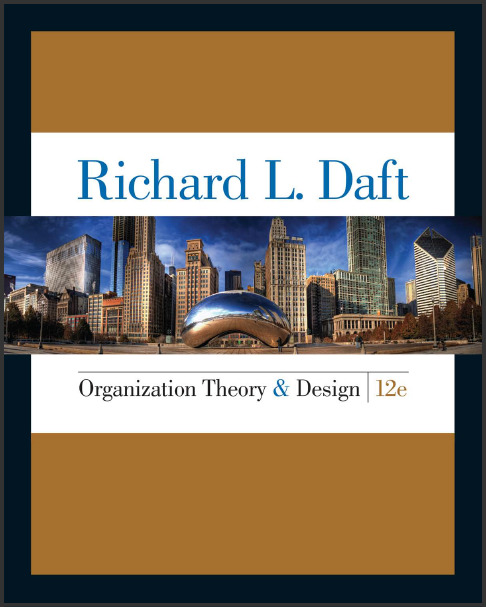Instruction Manual for Organization Theory and Design 12th Edition by Richard Daft ISBN 1285866347 9781285866345
$70.00 Original price was: $70.00.$35.00Current price is: $35.00.
Instant download (Instruction Manual) Organization Theory and Design 12th Edition Richard L. Daft after payment
Instruction Manual for Organization Theory and Design 12th Edition by Richard Daft – Ebook PDF Instant Download/Delivery: 1285866347, 9781285866345
Full download Organization Theory and Design 12th edition after payment

Product details:
ISBN 10: 1285866347
ISBN 13: 9781285866345
Author: Richard Daft
Introduce your students to the most progressive thinking about organizations today as acclaimed author Richard Daft balances recent, innovative ideas with proven classic theories and effective business practices. Daft’s best-selling ORGANIZATION THEORY AND DESIGN presents a captivating, compelling snapshot of contemporary organizations and the concepts driving their success. Recognized as one of the most systematic, well-organized texts in the market, the 12th edition of ORGANIZATION THEORY AND DESIGN helps current and future managers thoroughly prepare for the challenges they are certain to face in today’s business world. This revision showcases some of today’s most current examples and research alongside time-tested principles. Students see how many of today’s well-known organizations have learned to cope and even thrive amidst a rapidly changing, highly competitive international environment. Featured organizations include BP, Disney/Pixar, Volvo, Barnes & Noble, and Cisco Systems. Organization studies, proven cases, and illustrations provide the insights necessary to better understand modern organizations, while new and proven learning features give your students opportunities to apply concepts and refine their personal business skills and insights.
Organization Theory and Design 12th Table of contents:
Part 1: Introduction to Organizations
-
Chapter 1: Organizations and Organization Design
-
A Look Inside Xerox Corporation
-
What Went Wrong?
-
Entering the Digital Era
-
The Culture Problem
-
Shaking Up a Century-Old Company
-
“We No Longer Make Copiers”
-
-
Organization Design in Action
-
Topics
-
Current Challenges
-
Purpose of This Chapter
-
-
What Is an Organization?
-
Definition
-
From Multinationals to Nonprofits
-
Importance of Organizations
-
-
Dimensions of Organization Design
-
Structural Dimensions
-
Contingency Factors
-
Performance and Effectiveness Outcomes
-
-
The Evolution of Organization Design
-
Historical Perspectives
-
It All Depends: Key Contingencies
-
The Contrast of Organic and Mechanistic Designs
-
-
Contemporary Design Ideas: Radical Decentralization
-
Framework for the Book
-
Levels of Analysis
-
Plan of the Book
-
Plan of Each Chapter
-
-
Design Essentials
-
Key Concepts
-
Discussion Questions
-
Chapter 1 Workshop: Measuring Dimensions of Organization
-
Case for Analysis: It Isn’t So Simple: Infrastructure Change at Royce Consulting
-
Part 2: Organization Purpose and Structural Design
-
Chapter 2: Strategy, Organization Design, and Effectiveness
-
The Role of Strategic Direction in Organization Design
-
Organizational Purpose
-
Strategic Intent
-
Operating Goals
-
Goal Conflict and the Hybrid Organization
-
-
Two Frameworks for Selecting Strategy and Design
-
Porter’s Competitive Strategies
-
Miles and Snow’s Strategy Typology
-
How Strategies Affect Organization Design
-
-
Assessing Organizational Effectiveness
-
Definition
-
Who Decides?
-
Four Effectiveness Approaches:
-
Goal Approach
-
Resource-Based Approach
-
Internal Process Approach
-
Strategic Constituents Approach
-
-
-
An Integrated Effectiveness Model
-
Design Essentials
-
Key Concepts
-
Discussion Questions
-
Chapter 2 Workshop: Identify Your Goal Preferences
-
Case for Analysis: The Venable Museum of Art
-
Case for Analysis: Covington Corrugated Parts & Services
-
-
Chapter 3: Fundamentals of Organization Structure
-
Organization Structure
-
Information-Sharing Perspective on Structure
-
Centralized vs. Decentralized
-
Vertical Information Sharing
-
Horizontal Information Sharing and Collaboration
-
Relational Coordination
-
-
Organization Design Alternatives
-
Required Work Activities
-
Reporting Relationships
-
Departmental Grouping Options:
-
Functional, Divisional, and Geographic Designs
-
-
Functional Structure
-
Functional Structure with Horizontal Linkages
-
Divisional Structure
-
Geographic Structure
-
Matrix Structure
-
Conditions for the Matrix
-
Strengths and Weaknesses
-
Horizontal Structure
-
Characteristics, Strengths, and Weaknesses
-
Virtual Networks and Outsourcing
-
Hybrid Structure
-
Applications of Structural Design
-
Structural Alignment
-
Symptoms of Structural Deficiency
-
-
Design Essentials
-
Key Concepts
-
Discussion Questions
-
Chapter 3 Workbook: You and Organization Structure
-
Case for Analysis: C & C Grocery Stores, Inc.
-
Case for Analysis: Aquarius Advertising Agency
-
Part 3: Open System Design Elements
-
Chapter 4: The External Environment
-
The Organization’s Environment
-
Task Environment
-
General Environment
-
International Environment
-
The Changing Environment
-
-
Adapting to Complexity and Dynamism
-
Complexity and Dynamism
-
Framework
-
Adding Positions and Departments
-
Building Relationships
-
Differentiation and Integration
-
Organic vs. Mechanistic Management Processes
-
Planning, Forecasting, and Responsiveness
-
Dependence on Financial Resources
-
Influencing Financial Resources
-
Establishing Formal Relationships
-
-
Organization–Environment Integrative Framework
-
Design Essentials
-
Key Concepts
-
Discussion Questions
-
Chapter 4 Workshop: Organizations You Rely On
-
Case for Analysis: CPI Corporation: What Happened?
-
Case for Analysis: The Paradoxical Twins: Acme and Omega Electronics
-
-
Chapter 5: Interorganizational Relationships
-
Organizational Ecosystems
-
Is Competition Dead?
-
The Changing Role of Management
-
Interorganizational Framework
-
Resource Dependence
-
Power Implications
-
-
Collaborative Networks
-
Why Collaboration?
-
From Adversaries to Partners
-
-
Population Ecology
-
What Hinders Adaptation?
-
Organizational Form and Niche
-
Process of Ecological Change
-
Strategies for Survival
-
-
Institutionalism
-
The Institutional View and Organization Design
-
Institutional Similarity
-
-
Design Essentials
-
Key Concepts
-
Discussion Questions
-
Chapter 5 Workshop: The Shamatosi
-
Case for Analysis: Why is Cooperation So Hard?
-
Case for Analysis: Oxford Plastics Company
-
-
Chapter 6: Designing Organizations for the International Environment
-
Entering the Global Arena
-
Motivations for Global Expansion
-
Stages of International Development
-
-
Global Expansion Through International Alliances and Acquisitions
-
Challenges of Global Design
-
Increased Complexity and Differentiation
-
Increased Need for Coordination
-
Difficult Transfer of Knowledge and Innovation
-
-
Designing Structure to Fit Global Strategy
-
Strategies for Global vs. Local Opportunities
-
International Division
-
Global Product Division Structure
-
Global Geographic Division Structure
-
Global Matrix Structure
-
-
Additional Global Coordination Mechanisms
-
Global Teams
-
Headquarters Planning
-
Expanded Coordination Roles
-
Benefits of Coordination
-
-
The Transnational Model of Organization
-
Design Essentials
-
Key Concepts
-
Discussion Questions
-
Chapter 6 Workshop: Made in the U.S.A.?
-
Case for Analysis: TopDog Software
-
Case for Analysis: Rhodes Industries
-
People also search for Organization Theory and Design 12th:
richard l. daft organization theory and design 12th edition
daft rl 2015 organization theory and design 12th ed
daft rl 2016 organization theory and design 12th ed
organization theory and design 12th edition
organization theory and design 12th edition pdf
Tags:
Richard Daft,Organization Theory,Design


